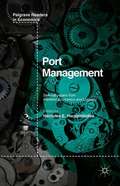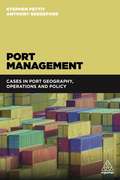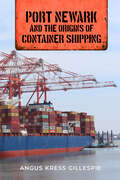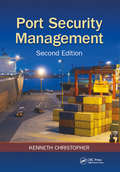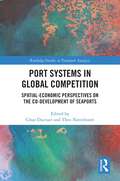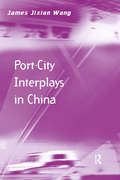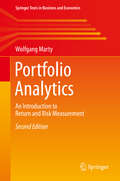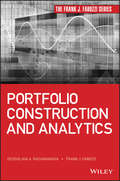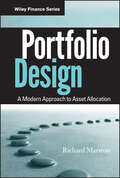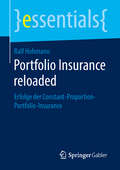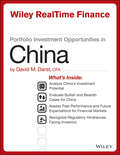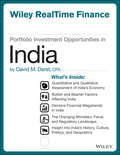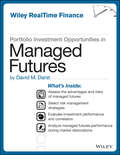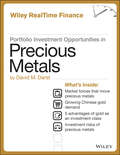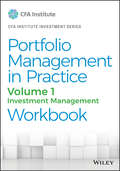- Table View
- List View
Port Management
by Hercules E. HaralambidesPort Management brings together a collection of seminal papers from Palgrave's journal Maritime Economics and Logistics. It is a dynamic volume, containing contributions from leading authors with different disciplinary backgrounds, representing a vast regional diversity. The volume provides authoritative and timely investigations into key topics in port economics, including research on: global supply chains, port networks, choice modelling, port infrastructure, competition, port pricing, efficiency in European seaports, and an analysis of Chinese container ports. It is essential reading for professionals, scholars, and researchers interested in port economics.
Port Management: Cases in Port Geography, Operations and Policy
by Stephen Pettit Anthony BeresfordPort Management looks at the numerous types of business interactions that occur at active ports. These include cooperating with other ports, coordinating deliveries with ships, overseeing port development, advertising and promotion, and enforcing security and environmental protection initiatives. Including research, practical insights and case studies, this book looks at quantitative methods and market analysis, maritime logistics, port planning and pricing, and commercial law.Port Management covers all the main aspects of management, administration and policy, and fills existing gaps in the literature in this area. Edited by two leading academics who have conducted research for the Department of Transport and the United Nations, this text is international in scope and includes research-based findings from a global team of contributors. It provides fascinating insights into the geography, economics, politics and trade involved in port management.
Port Newark and the Origins of Container Shipping
by Angus Kress GillespieContainer shipping is a vital part of the global economy. Goods from all around the world, from vegetables to automobiles, are placed in large metal containers which are transported across the ocean in ships, then loaded onto tractor-trailers and railroad flatbeds. But when and where did this world-changing invention get started? This fascinating study traces the birth of containerization to Port Newark, New Jersey, in 1956 when trucker Malcom McLean thought of a brilliant new way to transport cargo. It tells the story of how Port Newark grew rapidly as McLean’s idea was backed by both New York banks and the US military, who used containerization to ship supplies to troops in Vietnam. Angus Gillespie takes us behind the scenes of today’s active container shipping operations in Port Newark, talking to the pilots who guide the ships into port, the Coast Guard personnel who help manage the massive shipping traffic, the crews who unload the containers, and even the chaplains who counsel and support the mariners. Port Newark shines a spotlight on the unsung men and women who help this complex global shipping operation run smoothly. Since McLean's innovation, Port Newark has expanded with the addition of the nearby Elizabeth Marine Terminal. This New Jersey complex now makes up the busiest seaport on the East Coast of the United States. Some have even called it “America’s Front Door.” The book tells the story of the rapid growth of worldwide containerization, and how Port Newark has adapted to bigger ships with deeper channels and a raised bridge. In the end, there is speculation of the future of this port with ever-increasing automation, artificial intelligence, and automation.
Port Security Management
by Kenneth Christopher Steven B. FfflmSea and freshwater ports are a key component of critical infrastructure and essential for maintaining global and domestic economies. In order to effectively secure a dynamic port facility operation, one must understand the business of maritime commerce. Following in the tradition of its bestselling predecessor, Port Security Management, Second Edit
Port Systems in Global Competition: Spatial-Economic Perspectives on the Co-Development of Seaports (Routledge Studies in Transport Analysis)
by César DucruetIn a world where most international trade is carried by sea, each port can be seen as a unique chokepoint competing to attract ever more traffic and economic activities. However, ports can also be seen as parts of a wider system, which can be defined as a system of two or more ports located in proximity within a given area. Their fate and governance is jointly influenced when belonging to the same region, country, or transnational space. Investments, shocks, innovations, and delays occurring in one port often affect other ports within a certain spatial range and time lapse. Further understanding of such co-developments in port systems is necessary to go beyond local specificities, through a multidisciplinary and multi-level contribution. Port Systems in Global Competition is an answer to the strong and urgent need for reviewing the relevant theories, concepts, methods, and sources that can be mobilized for the analysis of port systems. With contributions from reputable scholars coming from no less than 11 countries in Europe, Asia, and North America, this book delves into the analysis of port systems from diverse disciplinary angles (geography, regional science, economics, management, engineering, and mathematics/computer sciences), covering innovative empirical approaches to various port systems in the world. The theoretical and empirical knowledge can support and enhance decision-making in relation with the development of ports, supply chains, and transport networks in general. This book is an ideal companion to academics and upper-level students interested in the analysis of transport and economic systems in general, as well as the effective ways to answer complex issues in transportation and socio-economic development. It will be a valuable resource for those researching or studying transportation and supply chains, maritime and port economics, as well as regional development and human geography.
Port-Cities and their Hinterlands: Migration, Trade and Cultural Exchange from the Early Seventeenth Century to 1939 (Routledge Explorations in Economic History)
by Robert LeeThis interdisciplinary book brings together eleven original contributions by scholars in the United Kingdom, continental Europe, America and Japan which represent innovative and important research on the relationship between cities and their hinterlands. They discuss the factors which determined the changing nature of port-hinterland relations in particular, and highlight the ways in which port-cities have interacted and intersected with their different hinterlands as a result of both in- and out-migration, cultural exchange and the wider flow of goods, services and information. Historically, maritime commerce was a powerful driving force behind urbanisation and by 1850 seaports accounted for a significant proportion of the world’s great cities. Ports acted as nodal points for the flow of population and the dissemination of goods and services, but their role as growth poles also affected the economic transformation of both their hinterlands and forelands. In fact, most ports, irrespective of their size, had a series of overlapping hinterlands whose shifting importance reflected changes in trading relations (political frameworks), migration patterns, family networks and cultural exchange. Urban historians have been criticised for being concerned primarily with self-contained processes which operate within the boundaries of individual towns and cities and as a result, the key relationships between cities and their hinterlands have often been neglected. The chapters in this work focus primarily on the determinants of port-hinterland linkages and analyse these as distinct, but interrelated, fields of interaction. Marking a significant contribution to the literature in this field, Port-Cities and their Hinterlands provides essential reading for students and scholars of the history of economics.
Port-City Interplays in China (Transport And Mobility Ser.)
by James Jixian WangChina has progressed dramatically since 1978 when the country started its economic reforms and opened up to the world economy. It took only three decades for China to develop from a closed, centrally planned economy with little sea-borne trade into the world's second largest economy with the largest container shipment volume in the world. The major coastal cities have been gateways linking China with the world and have experienced rapid urbanization and port growth. How has such port growth been speeded up and realized under strong state control and intervention? How have ports and their cities affected each other? What lessons can China’s port-cities learn from other countries, regions and cities? What will be the next stage of port-city interplays in China in this globalizing era? Answering these questions from a geographical perspective, James Wang looks into four sets of port-city relations in China: Economic and functional relations between port and city; port-city spatial relations; external network relations of cities through ports; and port-city governance. These relations formulate a conceptual framework which is used to interpret port-city interplays in individual ports and cities but also in multi-port regions such as the Pearl River Delta. Based on the author’s own research and investigations into more than 25 port cities in China over the past 18 years, this book provides vivid stories about China and challenge existing theories on port development.
Port-focal Logistics And Global Supply Chains
by Adolf K. Y. Ng John J. LiuThe global economy has experienced substantial changes in the past decades. They are not only unprecedented, but also far-reaching which effect on all walks of lives. Being the arteries of the global economy, transport, logistics and supply chains continue to evolve and adapt to the new phenomena, and have together become an integrated service professional. In this regard, being the nodal points, ports will play pivotal roles. Understanding such, Port Focal Logistics and Global Supply Chains investigates the trends and challenges that ports, logistics and supply chains have tackled in recent decades, and the appropriate way forward. A new concept, namely, port focal logistics is introduced which appreciates the efforts by previous studies in ports, logistics and supply chains, but simultaneously recognize the limitations, and the need for further improvements. Drawing experiences from both the developed and developing world, it provides first hand insight on the development strategies undertaken by ports, logistics and supply chain stakeholders around the world under diversified, often uncertain, circumstances, and thus provides scholars, policymakers, and industrial practitioners a comprehensive view on this rapidly changing sector.
Portable Alpha Theory and Practice: What Investors Really Need to Know
by Bill Gross Sabrina CallinAs an original innovator of the portable alpha concept, PIMCO has been managing an increasing number of different portable alpha strategies for investors since 1986. <P><P>And now, with Portable Alpha Theory and Practice, the PIMCO team shares their extensive experiences with you. Filled with in-depth insights and expert guidance, this reliable resource provides an informative look at portable alpha and key related concepts, as well as detailed discussion on the many ways it can be applied in real-world situations.
Portals, Agents, Auctions, Aggregators, and Other Intermediaries: An Atomic E-Business Model
by Peter Weill Michael R. VitaleSome of the most popular sites on the Internet are intermediaries-sites that stand between the buyer and the seller. This chapter examines several kinds of electronic intermediaries, exploring for each the reason it exists, its current role, and its possible future.
Portfolio Analytics
by Wolfgang MartyThis textbook first introduces the reader to return measurement and then goes on to compare the time-weighted rate of return (TWR) with the money-weighted rate of return (MWR). To emphasize the importance of risk in conjunction with return, different tracking errors are analyzed and ex-post versus ex-ante risk figures are compared. The author then proceeds to modern portfolio theory (MPT) and illustrates how the constraints interfere substantially in the construction of optimized portfolios. As a conclusion, the book provides the reader with all the essential aspects of investment controlling.
Portfolio Construction and Analytics
by Frank J. Fabozzi Dessislava PachamanovaA detailed, multi-disciplinary approach to investment analytics Portfolio Construction and Analytics provides an up-to-date understanding of the analytic investment process for students and professionals alike. With complete and detailed coverage of portfolio analytics and modeling methods, this book is unique in its multi-disciplinary approach. Investment analytics involves the input of a variety of areas, and this guide provides the perspective of data management, modeling, software resources, and investment strategy to give you a truly comprehensive understanding of how today's firms approach the process. Real-world examples provide insight into analytics performed with vendor software, and references to analytics performed with open source software will prove useful to both students and practitioners. Portfolio analytics refers to all of the methods used to screen, model, track, and evaluate investments. Big data, regulatory change, and increasing risk is forcing a need for a more coherent approach to all aspects of investment analytics, and this book provides the strong foundation and critical skills you need. Master the fundamental modeling concepts and widely used analytics Learn the latest trends in risk metrics, modeling, and investment strategies Get up to speed on the vendor and open-source software most commonly used Gain a multi-angle perspective on portfolio analytics at today's firms Identifying investment opportunities, keeping portfolios aligned with investment objectives, and monitoring risk and performance are all major functions of an investment firm that relies heavily on analytics output. This reliance will only increase in the face of market changes and increased regulatory pressure, and practitioners need a deep understanding of the latest methods and models used to build a robust investment strategy. Portfolio Construction and Analytics is an invaluable resource for portfolio management in any capacity.
Portfolio Construction, Measurement, and Efficiency
by John B. GuerardThis volume, inspired by and dedicated to the work of pioneering investment analyst, Jack Treynor, addresses the issues of portfolio risk and return and how investment portfolios are measured. In a career spanning over fifty years, the primary questions addressed by Jack Treynor were: Is there an observable risk-return trade-off? How can stock selection models be integrated with risk models to enhance client returns? Do managed portfolios earn positive, and statistically significant, excess returns and can mutual fund managers time the market? Since the publication of a pair of seminal Harvard Business Review articles in the mid-1960's, Jack Treynor has developed thinking that has greatly influenced security selection, portfolio construction and measurement, and market efficiency. Key publications addressed such topics as the Capital Asset Pricing Model and stock selection modeling and integration with risk models. Treynor also served as editor of the Financial Analysts Journal, through which he wrote many columns across a wide spectrum of topics. This volume showcases original essays by leading researchers and practitioners exploring the topics that have interested Treynor while applying the most current methodologies. Such topics include the origins of portfolio theory, market timing, and portfolio construction in equity markets. The result not only reinforces Treynor's lasting contributions to the field but suggests new areas for research and analysis.
Portfolio Decision Analysis
by Ahti Salo Jeffrey Keisler Alec MortonPortfolio Decision Analysis: Improved Methods for Resource Allocation provides an extensive, up-to-date coverage of decision analytic methods which help firms and public organizations allocate resources to 'lumpy' investment opportunities while explicitly recognizing relevant financial and non-financial evaluation criteria and the presence of alternative investment opportunities. In particular, it discusses the evolution of these methods, presents new methodological advances and illustrates their use across several application domains. The book offers a many-faceted treatment of portfolio decision analysis (PDA). Among other things, it (i) synthesizes the state-of-play in PDA, (ii) describes novel methodologies, (iii) fosters the deployment of these methodologies, and (iv) contributes to the strengthening of research on PDA. Portfolio problems are widely regarded as the single most important application context of decision analysis, and, with its extensive and unique coverage of these problems, this book is a much-needed addition to the literature. The book also presents innovative treatments of new methodological approaches and their uses in applications. The intended audience consists of practitioners and researchers who wish to gain a good understanding of portfolio decision analysis and insights into how PDA methods can be leveraged in different application contexts. The book can also be employed in courses at the post-graduate level.
Portfolio Design
by Richard C. MarstonAn in-depth look at the role of asset allocation in today's investment environmentIn Modern Asset Allocation author Richard Marston shows you how to jump back into the market with the reminder that the key to investing is to do it for the long-run. And in looking at investing for the long-term, what matters most is asset allocation.This reliable resource offers a fresh look at asset allocation, and discusses its importance in today's investment environment. Along the way, it examines how returns on stocks, bonds, international equities, hedge funds, real estate, commodities, and the like all increase and are of added value to a portfolio when they are strategically allocated.Examines all of the major asset classes that go into modern portfolios and asks how much they add to portfolio diversificationAddresses the issues financial professionals face when attempting to provide diversified portfolios for their clientsBased on sessions that Richard Marston has developed for the CIMA programAsset allocation is still thriving as a method to achieve long-term profitability. This book contains the insights that you need to excel at this endeavor.
Portfolio Insurance reloaded: Erfolge Der Constant-proportion-portfolio-insurance (Essentials)
by Ralf HohmannDieses essential gibt einen Überblick zu aktuellen Erscheinungsformen der Portfolio Insurance sowie zur Anwendbarkeit der Constant-Proportion-Portfolio-Insurance mit vielfältigen Finanztiteln auf unterschiedlichen Geld- und Kapitalmärkten. Die empirische Untersuchung mit historischen Daten dazu umfasst einen Zeitraum von über sechs Jahren und ist in diesem Umfang ohne Vergleich. Die Darstellung und Vorgehensweise im Rahmen der Strategie erfolgt detailliert und wird mit Beispielen zur Replizierbarkeit unterstützt. Gleiches gilt für die empirischen Ergebnisse der unterschiedlichen Ergebnisse und der jeweiligen Finanztitel, die mit der Portfolio Insurance geschützt werden. Als Ergebnis wird deutlich, dass Transaktionskosten keinen wesentlichen Einfluss auf das Ergebnis der Strategien haben, negative Zinssätze jedoch den Erfolg maßgeblich negativ beeinflussen können.
Portfolio Investment Opportunities in China (Wiley RealTime Finance)
by David M. DarstEssential research on the Chinese economy for investors and asset managers In this handy new e-book, bestselling author David M. Darst provides the latest information on investment opportunities in China's growing economy. Constraints of language and time zones, geographical distance, foreign currency transaction costs, and political and cultural factors can make it difficult to assess, value, and invest in China's economy. Portfolio Investment Opportunities in China gives investors the information they need to make intelligent choices, including coverage of Chinese history, politics, and culture—all with an eye towards helping investors pinpoint those businesses and industries that offer the best potential returns. Covers key factors western investors need to know about China, with specific focus on China’s economy, investment landscape, and financial potential Written by David M. Darst, CFA, the bestselling author of The Little Book That Saves Your Assets Covers key factors western investors need to know about China, with specific focus on China's economy, investment landscape, and financial potential
Portfolio Investment Opportunities in India
by David M. DarstInvestment strategies and knowledge for asset managers investing in IndiaThis e-book only investment report will detail India's asset classes, its investment strategies, risks and advantages, and politics and cultural history with an eye toward serving investment advisors and asset managers looking for up-to-date investment knowledge on specific alternative asset classes.
Portfolio Investment Opportunities in Managed Futures (Wiley RealTime Finance)
by David M. DarstNew research and investment strategies for asset managers in managed futures In this handy new e-book, bestselling author David M. Darst provides the latest information on managed futures and their appropriate role within investment portfolios. The first section of the e-book covers select investment advantages and potential risks of managed futures, including historical background on futures, their advantages, risks involved, and key trends and drivers. The second section offers a summary of managed futures investment performance and correlation, including the performance of the major futures indices. The remaining sections provide an overview of the current investment landscape, a glossary of available indices, and important sources of further information. Portfolio Investment Opportunities in Managed Futures gives investors the information they need to make intelligent investment decisions in this important asset class. Covers key factors investors need to know about managed futures, including advantages, risks, and investment performance Written by David M. Darst, CFA, the bestselling author of The Little Book That Saves Your Assets Perfect for individual investors, financial advisors, and CFAs interested in how managed futures can meaningfully improve the risk-reward profile of their portfolios
Portfolio Investment Opportunities in Precious Metals (Wiley RealTime Finance)
by David M. DarstNew research and investment strategies for asset managers in precious metals In this handy new e-book, bestselling author David M. Darst provides valuable perspective on the role and positioning of gold and other precious metals within an economic, financial, and portfolio context. It covers the advantages and disadvantages, risks and rewards of investing in precious metals and sheds light on the key factors that drive prices, including supply and demand forces, inflation and deflation, geopolitical conditions, interest rates, and the global monetary system. The book also offers detailed information on specific vehicles that provide exposure to precious metals, as well as sources of further information available in print and online. Portfolio Investment Opportunities in Precious Metals gives investors the information they need to make intelligent investment decisions in precious metals. Covers key factors investors need to know about precious metals, including advantages, risks, and investment performance Written by David M. Darst, CFA, the bestselling author of The Little Book That Saves Your Assets Perfect for individual investors, financial advisors, and CFAs interested in the role that precious metals play in investment portfolios
Portfolio Life
by David D. Corbett Richard HigginsPraise for Portfolio Life"Dave Corbett's book turns two simple ideas into a program for life-enrichment, that you can create a life expressly for yourself and that the so-called retirement years are the best time to do it. Drawing on a lifetime of work with people who were rethinking what they wanted and their direction, he shows how to do both those things. Be warned: If you read the book, you're going to be changed. But I think you'll like how you turn out."--Bill Bridges, author, Transitions and Job Shift"Dave's book reveals a powerful and profound formula for crafting a genuinely rich life. If you agree that retirement is pass?, and you are a lifelong learner and have a desire to make your life count in a deeply fulfilling way, you will love this book."--Fred Harburg, former chief learning officer and president, Motorola University"Healthy, fit, financially secure, and happy for another 40 years? Is there really that kind of gold over 'them thar' hills? Yes, and Portfolio Life is the guide, leading boomers to a life path never before traveled by so many. Don't pass 50 without it."--Natalie Jacobson, news anchor, WCVB-TV Boston"This is the work of a wise, thoughtful author with decades of experience helping people be more successful in the next chapter of their lives. It will help you embrace change and explore the possibilities that come with an additional 20 to 30 productive years to be designed and lived on your own terms."--Anne Szostak, chairman, The Boys & Girls Clubs of America"This timely book should be read by anyone of any age who wants his or her life to have meaning and purpose beyond the accumulation of money and things."--Millard Fuller, founder, Habitat for Humanity and the Fuller Center for Housing
Portfolio Management Under Stress
by Riccardo RebonatoPortfolio Management under Stress offers a novel way to apply the well-established Bayesian-net methodology to the important problem of asset allocation under conditions of market distress or, more generally, when an investor believes that a particular scenario (such as the break-up of the Euro) may occur. Employing a coherent and thorough approach, it provides practical guidance on how best to choose an optimal and stable asset allocation in the presence of user specified scenarios or 'stress conditions'. The authors place causal explanations, rather than association-based measures such as correlations, at the core of their argument, and insights from the theory of choice under ambiguity aversion are invoked to obtain stable allocations results. Step-by-step design guidelines are included to allow readers to grasp the full implementation of the approach, and case studies provide clarification. This insightful book is a key resource for practitioners and research academics in the post-financial crisis world.
Portfolio Management in Practice, Volume 1: Investment Management (CFA Institute Investment Series)
by CFA InstitutePortfolio Management in Practice, Volume 1: Investment Management delivers a comprehensive overview of investment management for students and industry professionals. As the first volume in the CFA Institute’s new Portfolio Management in Practice series, Investment Management offers professionals looking to enhance their skillsets and students building foundational knowledge an essential understanding of key investment management concepts. Designed to be an accessible resource for a wide range of learners, this volume explores the full portfolio management process. Inside, readers will find detailed coverage of: Forming capital market expectations Principles of the asset allocation process Determining investment strategies within each asset class Integrating considerations specific to high net worth individuals or institutions into chosen strategies And more To apply the concepts outlined in the Investment Management volume, explore the accompanying Portfolio Management in Practice, Volume 1: Investment Management Workbook. The perfect companion resource, this workbook aligns chapter-by-chapter with Investment Management for easy referencing so readers can draw connections between theoretical content and challenging practice problems. Featuring contributions from the CFA Institute’s subject matter experts, Portfolio Management in Practice, Volume 1: Investment Management distills the knowledge forward-thinking professionals will need to succeed in today’s fast-paced financial world.
Portfolio Management in Practice, Volume 1: Investment Management Workbook (CFA Institute Investment Series)
by CFA InstituteThe companion workbook to the Investment Management volume in the CFA Institute’s Portfolio Management in Practice series provides students and professionals with essential practice regarding key concepts in the portfolio management process. Filled with stimulating exercises, this text is designed to help learners explore the multifaceted topic of investment management in a meaningful and productive way. The Investment Management Workbook is structured to further readers’ hands-on experience with a variety of learning outcomes, summary overview sections, challenging practice questions, and solutions. Featuring the latest tools and information to help users become confident and knowledgeable investors, this workbook includes sections on professionalism in the industry, fintech, hedge fund strategies, and more. With the workbook, readers will learn to: Form capital market expectations Understand the principles of the asset allocation process Determine comprehensive investment strategies within each asset class Integrate considerations specific to high net worth individuals or institutions into the selection of strategies Execute and evaluate chosen strategies and investment managers Well suited for individuals who learn on their own, this companion resource delivers an example-driven method for practicing the tools and techniques covered in the primary Investment Management volume, incorporating world-class exercises based on actual scenarios faced by finance professionals every day.
Portfolio Management in Practice, Volume 2: Asset Allocation (CFA Institute Investment Series)
by CFA InstituteDiscover the latest essential resource on asset allocation for students and investment professionals. Part of the CFA Institute’s three-volume Portfolio Management in Practice series, Asset Allocation offers a deep, comprehensive treatment of the asset allocation process and the underlying theories and markets that support it. As the second volume in the series, Asset Allocation meets the needs of both graduate-level students focused on finance and industry professionals looking to become more dynamic investors. Filled with the insights and industry knowledge of the CFA Institute’s subject matter experts, Asset Allocation effectively blends theory and practice while helping the reader expand their skillsets in key areas of interest. This volume provides complete coverage on the following topics: Setting capital market expectations to support the asset allocation process Principles and processes in the asset allocation process, including handling ESG-integration and client-specific constraints Allocation beyond the traditional asset classes to include allocation to alternative investments The role of exchange-traded funds can play in implementing investment strategies An integrative case study in portfolio management involving a university endowment To further enhance your understanding of tools and techniques explored in Asset Allocation, don’t forget to pick up the Portfolio Management in Practice, Volume 2: Asset Allocation Workbook. The workbook is the perfect companion resource containing learning outcomes, summary overview sections, and challenging practice questions that align chapter-by-chapter with the main text.
